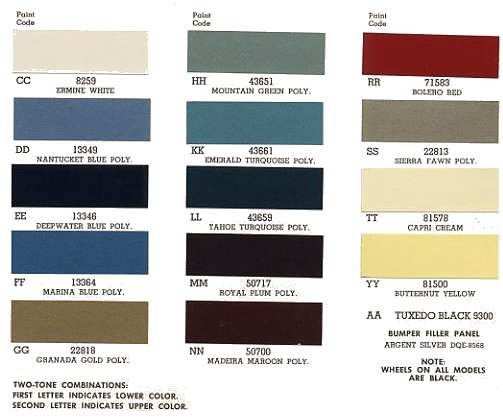|
GM literature states, "Convertible top: White (Regular
Production), Black or Medium Blue (RPO C05) were available with any exterior
color." The convertible top was available with both manual and power versions.
The numbers below appear on the Fisher Body Plate to
identify color of convertible/vinyl top.
|
COLOR
|
CONVERTIBLE TOP COLORS |
| |
1 ~ White (standard) |
| |
2 ~ Black |
| |
4 ~ Medium Blue |
|
GM literature states, "Vinyl top option
(RPO C08): Black or Lt. Fawn with any exterior color."
|
|
COLOR
|
VINYL TOP COLORS |
| |
2 ~ Black |
| |
6 ~ Light Fawn |
U.S. Paint Code Chart

GM of Canada Paint Code Chart
|
General Motors of Canada LTD offered many
of the same colors as their U.S. counterpart with three additional
colors available (noted with asterisk), Verde Green Metallic,
Silver Glaze Metallic, and Antique Pewter
Metallic. Several other Canadian colors were identical
to U.S. colors, only the names were a bit different.
|
| Color |
Color Name |
Paint Code |
|
|
Enamel |
Lacquer |
| |
Tuxedo Black |
A |
3A |
| |
Provincial White |
C |
3C |
| |
Nantucket Blue Metallic |
D |
3D |
| |
Deepwater Blue Metallic |
E |
3E |
| |
Marina Blue Metallic |
F |
3F |
| |
Grenada Gold Metallic |
G |
3G |
| |
Mountain Green Metallic |
H |
3H |
| |
Verde Green Metallic* |
J |
3J |
| |
Emerald Turquoise Metallic |
K |
3K |
| |
Tahoe Turquoise Metallic |
L |
3L |
| |
Plum Mist Metallic |
M |
3M |
| |
Madeira Maroon Metallic |
N |
3N |
| |
Silver Glaze Metallic* |
P |
3P |
| |
Bolero Red |
R |
3R |
| |
Sierra Fawn Metallic |
S |
3S |
| |
Capri Cream |
T |
3T |
| |
Antique Pewter Metallic* |
V |
3V |
| |
Butternut Yellow |
Y |
3Y |
|
Paint Process
-
RUSTPROOFING: Assembled car bodies
are chemically sprayed to clean and etch the metal surfaces
for corrosion resistance and paint adhesion. Unassembled
sheet metal parts follow the same process.
-
BODY AND SHEET METAL PRIMERS: Four
corrosion resistant primers, especially formulated,
are hand sprayed on the body in areas where rust might
develop. Lower areas considered especially vulnerable
are coated with another rust inhibiting compound.
-
PRIMER COAT is applied to all outside
and inside surfaces of front fenders and hoods. The
parts are mechanically dipped or flow-coated to insure
coating in all seams and secluded areas and baked at
390 degrees F. for 30 minutes. A coat of sealer is then
applied by hand spray to all surfaces requiring another
coat of lacquer.
-
FLASH PRIMER AND PRIMER-SURFACER
COATS: An air-dry flash primer coat is hand sprayed
on surfaces below the body belt line. Then a gray primer-surfacer
coat is hand sprayed on all outside surfaces of the
body and oven baked for 45 minutes at 285 degrees F.
-
INITIAL SANDING: Power wet sanding,
followed by hand sanding, is done on all body surfaces
requiring lacquering. This ensures a smooth surface
for the lacquer finish. to remove the water, the body
is wiped and run through an infra-red oven.
-
LACQUERING: Three coats of acrylic
lacquer are spread on the exterior surfaces of the body
and sheet metal parts to build up a finish of the required
thickness for each color.
-
INITIAL BAKING: To harden the paint
for final sanding, the body and sheet metal parts are
baked for approximately 10 minutes at 200 degrees F.
-
FINAL SANDING: To remove body surface
defects, power and hand sanding is done with fine grit
sandpaper and mineral spirits as a wetting agent. Sanded
areas are wiped to insure a clean surface before final
baking.
-
FINAL BAKING: To assure a durable,
hard, high luster finish the lacquer is baked for 30
minutes at 275 degrees F. Reheating the lacquer after
final sanding permits paint film to soften, allowing
surface blemishes and sanding scratches to disappear
during the thermo-reflow process.
-
UNDERCOATING: To block out road noise,
an asbestos fiber sound deadener with asphalt base is
sprayed inside the wheel housings and on the bottom
of the underbody at designated areas.
-
PAINT REPAIR AND PROTECTION: Mars,
nicks, or scratches that occur during final assembly
are corrected at the factory before shipment. When required,
light "slush" polishing brings painted surfaces to a
high luster finish. Wax is applied to all horizontal
surfaces of each vehicle and polished out for protection
during shipment. The wax contains no silicones, thus
eliminating any paint contamination problem.
|
|
|
































